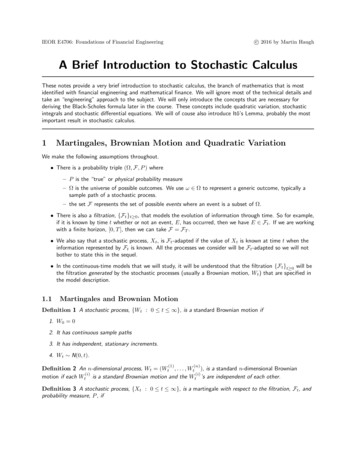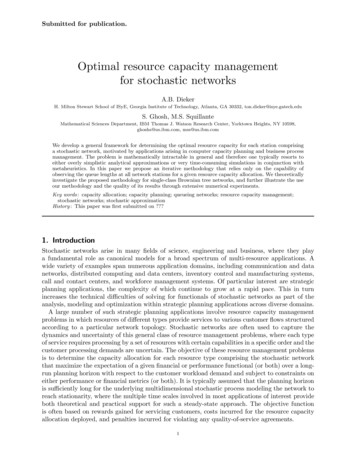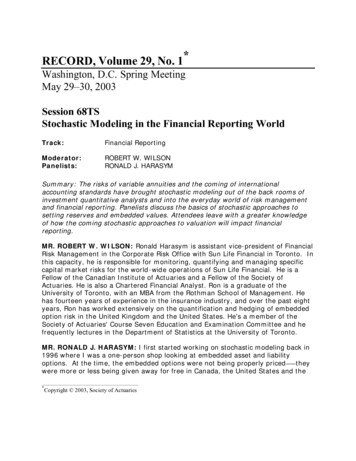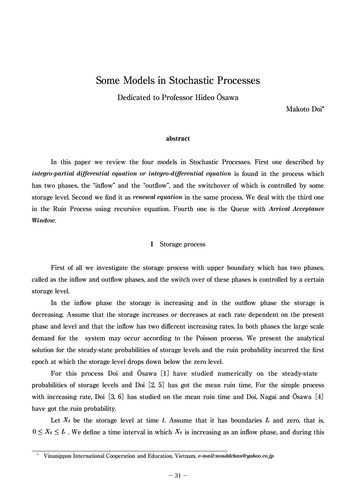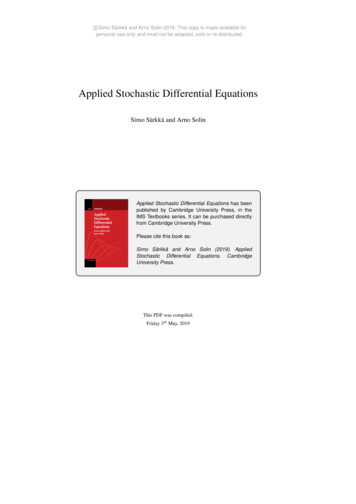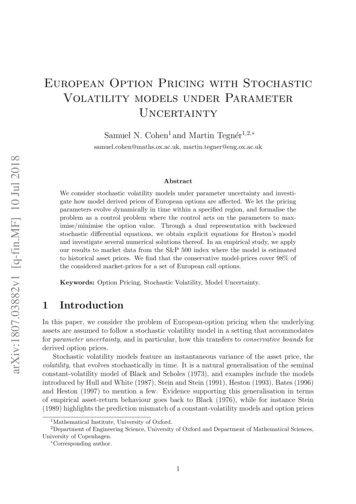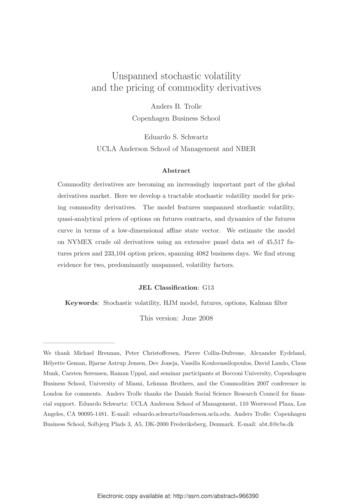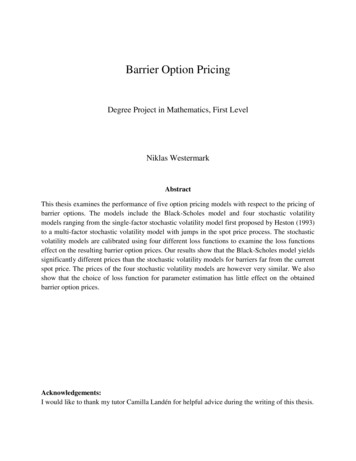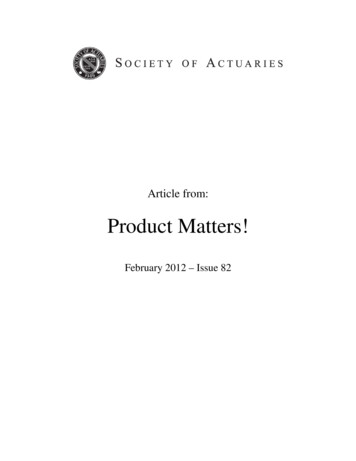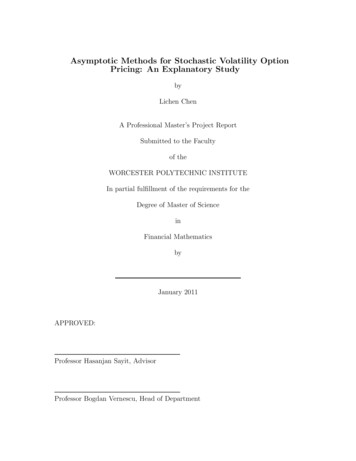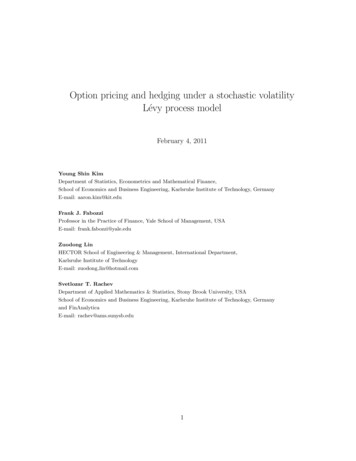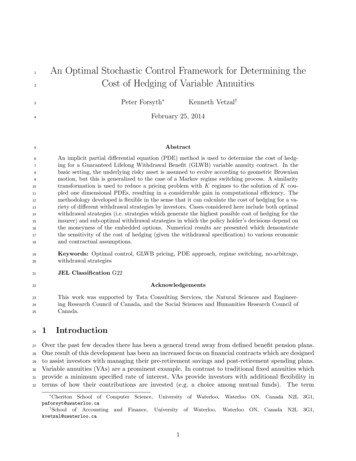
Transcription
An Optimal Stochastic Control Framework for Determining theCost of Hedging of Variable Annuities12Peter Forsyth 3Kenneth Vetzal†4February 25, 20145Abstract6An implicit partial differential equation (PDE) method is used to determine the cost of hedging for a Guaranteed Lifelong Withdrawal Benefit (GLWB) variable annuity contract. In thebasic setting, the underlying risky asset is assumed to evolve according to geometric Brownianmotion, but this is generalized to the case of a Markov regime switching process. A similaritytransformation is used to reduce a pricing problem with K regimes to the solution of K coupled one dimensional PDEs, resulting in a considerable gain in computational efficiency. Themethodology developed is flexible in the sense that it can calculate the cost of hedging for a variety of different withdrawal strategies by investors. Cases considered here include both optimalwithdrawal strategies (i.e. strategies which generate the highest possible cost of hedging for theinsurer) and sub-optimal withdrawal strategies in which the policy holder’s decisions depend onthe moneyness of the embedded options. Numerical results are presented which demonstratethe sensitivity of the cost of hedging (given the withdrawal specification) to various economicand contractual assumptions.78910111213141516171820Keywords: Optimal control, GLWB pricing, PDE approach, regime switching, no-arbitrage,withdrawal strategies21JEL Classification G221922Acknowledgements23This work was supported by Tata Consulting Services, the Natural Sciences and Engineering Research Council of Canada, and the Social Sciences and Humanities Research Council ofCanada.2425262728293031321IntroductionOver the past few decades there has been a general trend away from defined benefit pension plans.One result of this development has been an increased focus on financial contracts which are designedto assist investors with managing their pre-retirement savings and post-retirement spending plans.Variable annuities (VAs) are a prominent example. In contrast to traditional fixed annuities whichprovide a minimum specified rate of interest, VAs provide investors with additional flexibility interms of how their contributions are invested (e.g. a choice among mutual funds). The term Cheriton School of Computer Science, University of Waterloo, Waterloo ON, Canada N2L 3G1,paforsyt@uwaterloo.ca†School of Accounting and Finance, University of Waterloo, Waterloo ON, Canada N2L 3G1,kvetzal@uwaterloo.ca1
5859606162636465666768697071727374“variable” refers to the fact that the returns can vary according to the investment choices made. Inthe U.S., VAs offer a tax-deferral advantage because taxes are not paid until income is withdrawn.1Although VAs have been offered for many years, the market for them exhibited dramatic growthbeginning in the 1990s: according to Chopra et al. (2009), the annual rate of growth in the U.S.VA market during that decade was 21%, and the level of total assets reached almost USD 1 trillionby 2001. While the decline of traditional defined benefit pension plans was a contributing factor,another reason was that VA contracts began to incorporate several additional features which madethem more attractive to investors. As noted by Bauer et al. (2008), these features can be dividedinto two broad types: guaranteed minimum death benefits (GMDBs) and guaranteed minimumliving benefits (GMLBs). GMDBs provide a payout at least equal to the original amount invested(or this amount grossed up by a guaranteed minimum rate of return) if a policy holder dies. Theseprovisions first became widely adopted in VA contracts in the 1990s. There are several types ofGMLBs: guaranteed minimum accumulation benefits and guaranteed minimum income benefitsboth give investors a guaranteed asset level at some specified future time, the former in a lumpsum amount and the latter in the form of an annuity. Guaranteed minimum withdrawal benefits(GMWBs) allow investors to withdraw funds each period (e.g. year) from their VA accounts up tospecified limits, regardless of the investment performance of the accounts.2 A variation of GMWBsknown as guaranteed lifelong withdrawal benefits (GLWBs) permits such withdrawals as long as theinvestor remains alive. These various GMLB features were widely introduced to the U.S. marketin the early 2000s. The size of assets in U.S. VA accounts grew to about USD 1.5 trillion by theend of 2007 (Chopra et al., 2009). In addition to the U.S., similar VA-type contracts have beenmarketed to investors in many other countries, including Japan, the U.K., Germany, Italy, France,and Canada. Further information about the historical development of the VA market and the typesof contracts available can be found in Bauer et al. (2008) and Chopra et al. (2009).The onset of the financial crisis in the latter half of 2007 resulted in dismal equity returns,sustained low interest rates, and high market volatility. Many of the options embedded into VAcontracts became quite valuable, and insurers were faced with the prospect of having to makelarge payments in order to meet the terms of these written options. Some insurers were noteffectively hedged, and large losses resulted (Kling et al., 2011). Subsequently, VA sales havegenerally declined, in part because insurers have reduced offerings, raised fees, and attempted tobuy existing investors out of their contracts (Tracer and Pak, 2012). MetLife took a USD 1.6 billionimpairment charge related to its annuity business in the third quarter of 2012 (Tracer and Pak,2012), and some firms have tried to sell off their annuity business units (Nelson, 2013).3An unfortunate aspect of this is that in principle it makes sense for relatively sophisticatedfinancial institutions to offer risk management services for retail clients. However, this is subject tothe caveat that the institutions themselves need to adopt effective hedging strategies to offset therisk exposures resulting from selling these types of contracts. Many insurers did attempt to hedgethe risks. According to a report cited by Chopra et al. (2009), hedging programs saved the industryabout 40 billion in September-October 2008, offsetting almost 90% of the industry’s increase inliability valuations during that period. However, the hedging programs which were adopted wereclearly not entirely successful and so there is definite scope for research as to how they might beimproved.1The deferral advantage is offset somewhat by having withdrawals taxed at ordinary income rates rather thancapital gains rates.2Investors can withdraw funds in excess of the specified limits, but are typically charged penalties to do so.3Even so, as a reflection of earlier sales and recent stronger equity market performance, total assets in U.S. VAcontracts reached an all-time high of around USD 1.7 trillion at the end of the first quarter of 2013 (Insured RetirementInstitute, 2013).2
6117This article contributes to the literature by developing a simple and computationally efficientframework to evaluate the cost of hedging these types of contracts. Of course, the cost of hedgingdepends on the issuer’s hedging strategy, so it is worth discussing this in more detail here. As apoint of comparison, consider the standard approach for valuing an American put option on someunderlying asset. The fundamental idea is to determine the initial cost of a dynamic self-financingreplicating portfolio which is designed to provide an amount at least equal to the payoff of thecontract, on the assumption that the purchaser of the contract adopts an exercise strategy thatmaximizes the monetary value of the contract. If the purchaser follows any other exercise strategy,the contract writer will be left with a surplus. The initial cost of establishing this hedging strategyis the no-arbitrage price of the contract—if the contract were to trade for a different price than thisportfolio, then arbitrage profits could be made in principle by exploiting this price difference. Thisis not a pure arbitrage argument, in the sense that it is subject to modelling assumptions about thevalue of the underlying asset and parameters such as volatility. The VA setting differs in two keyrespects. First, the option premium is not paid up as an up-front instalment, but rather is deductedover time as a proportional fee applied to the value of the assets in the investor’s account. Second,it is important to allow for alternative possible assumptions regarding the investor’s option exercisestrategy. This is because an investor may follow what appears to be a sub-optimal strategy that doesnot maximize the monetary value of the embedded option. This could be for idiosyncratic reasonssuch as liquidity needs or tax circumstances.4 We use the term “cost of hedging” to refer to the fairhedging fee to be deducted that finances a dynamic replicating portfolio for the options embeddedin the contract under the assumption of a particular exercise strategy. The replicating portfolio ismanaged so as to provide sufficient funds to meet any future payouts that arise from writing thecontracts, at least under the model considered. This is distinguished from the “no-arbitrage fee” bythe possibility of alternative exercise behaviour. Our terminology is intended to remind the readerof this generalization: the no-arbitrage fee would be a special case under the assumption that theinvestor’s strategy is to maximize the monetary value of the options embedded in the contract.Of course, as with the no-arbitrage value of standard option contracts, the cost of hedging for VAcontracts is still subject to modelling assumptions about the value of the underlying asset overtime. We also emphasize that the cost of hedging calculated under the assumption that investorsact to maximize the value of the options that they hold does offer an important benchmark in thatit is a worse case scenario for the contract writer—again, under the particular model assumed forthe value of the underlying asset.In this article, we will focus exclusively on GLWBs. Our approach can easily be adapted tothe simpler case of GMWBs with a fixed maturity date, but recent concerns over longevity risk(i.e. retirees outliving their savings) imply that GLWBs may be of greater significance.5 Thesecontracts are typically initiated by making a single lump sum payment to an insurance company.This payment is then invested in risky assets, usually a mutual fund. The benefit base, or guaranteeaccount balance, is initially set to the amount of the lump sum payment. The holder of the contractis entitled to withdraw a fixed fraction of the benefit base each period (e.g. year) for life, even ifthe actual investment in the risky asset declines to zero. Upon the death of the contract holder, hisor her estate receives the remaining amount in the risky asset account. Typically, these contractshave ratchet provisions (a.k.a. “step-ups”), which periodically increase the benefit base if the riskyasset investment has increased to a value larger than the guarantee account value. In addition,4Prepayment options in mortgages offer a useful analogy. While these options may be exercised for the monetaryadvantage of being able to re-finance a home at a lower prevailing interest rate, they could also be exercised for avariety of other reasons such as a transfer of employment, a divorce, or a simple desire to move to a larger house.5In addition, since GLWBs can last for much longer than GMWBs, it is more important to develop efficientvaluation methods for GLWBs.3
51152153154155156157158159160161162163164165the benefit base may also be increased if the contract holder does not withdraw in a given year.This is known as a bonus or roll-up. Finally, the contract holder may withdraw more than thecontractually specified amount, including complete surrender of the contact, upon payment of apenalty. Complete surrender here means that the contract holder withdraws the entire amountremaining in the investment account, and the contract terminates. In most cases, the penalty forfull or partial surrender declines to zero after five to seven years. As noted above, investors arecharged a proportional fee from their risky asset accounts to pay for these features.The valuation and hedging of the various provisions embedded into VA contracts is a challengingexercise as the options involved are long term, path-dependent, and complex. Investors can bemodelled as facing a non-trivial optimal stochastic impulse control problem when determiningtheir withdrawal strategies in GMWB/GLWB contracts. In general, the prior literature on thesecontracts has taken one of two alternative approaches: (i) focusing primarily on the investor’soptimization problem in the context of a relatively simple specification such as geometric Brownianmotion (GBM) for the stochastic evolution of the underlying investment; or (ii) concentrating ona richer stochastic specification incorporating features such as random volatility and/or randominterest rates, while assuming that the investor follows a simple pre-specified strategy, typicallyinvolving always withdrawing the contractually specified amount each period (i.e. the maximumwithdrawal that can be made without paying a penalty), no matter what happens to the valueof the investment account. As an early example of the former approach, Milevsky and Salisbury(2006) value GMWB contracts under GBM and two extreme cases of policy holder behaviour:withdrawal of the contractually specified amount at all times in all circumstances or maximizingthe economic value of the embedded options. Numerical PDE techniques are used to solve thevaluation problems. The fair hedging fee for the contract is shown to increase substantially ifinvestors are assumed to act to maximize the value of their embedded options rather than topassively withdraw the contract amount. Dai et al. (2008) model the GMWB pricing problemas a singular stochastic control problem in the GBM setting and provide an efficient numericalPDE approach for solving the problem. Illustrative calculations show dramatic differences in thefair hedging fee as parameters such as the allowed withdrawal amount, the penalty for excesswithdrawals, and volatility are changed. Chen et al. (2008) provide a detailed study of the effectsof various parameters on the fair fees for hedging GMWBs, showing that in addition to assumedlevels for volatility and the risk-free rate, the fact (often ignored in the literature) that the totalfees charged to investors is split between fees made available for hedging purposes and fees paid formanaging the underlying mutual funds can have large effects. Most of the results reported are forthe case of GBM, but an extension to a jump-diffusion setting is also considered and shown to havea potentially significant impact on the fair hedging fee. In addition, Chen et al. (2008) also explorean alternative assumption about policy holder behaviour based on an idea put forth by Ho et al.(2005). Under this scenario, the contract holder is assumed to withdraw the contract amount unlessthe embedded options are sufficiently deep-into-the-money, in which case the assumption is thatthe holder will act “optimally” to capture the option value. Again, the implied fair hedging fees arequite sensitive to this behavioural specification. In Bauer et al. (2008), a very general frameworkis developed for pricing a wide variety of VA contracts. The numerical cases considered are all inthe GBM context. In contrast to the papers cited above which rely on various types of numericalPDE approaches, Bauer et al. (2008) use Monte Carlo methods for some policy holder behaviourassumptions and a combination of Monte Carlo methods and a numerical integration technique todetermine the optimal strategy. However, the approaches considered are quite inefficient comparedto the PDE-based alternatives, at least in the simple GBM setting. The general framework ofBauer et al. is applied to the specific case of GLWBs by Holz et al. (2012). A variety of contractualfeatures are considered, as well as some alternative assumptions about policy holder behaviour. The4
99200201202203204205206207208209stochastic setting is GBM, and Monte Carlo methods are used. Again, the same general conclusionemerges as with several other studies: the fair hedging fee for the contract is extremely sensitiveto assumptions about behaviour, the risk-free rate, volatility, and contractual provisions. Piscopo(2010) assumes GBM and uses a Monte Carlo method to estimate fair hedging fees for GLWBs fortwo cases of policy holder behaviour: always withdraw the contract amount each period, or do soexcept if the value of the account less any penalty is less than the present value of the future benefits,in which case completely withdraw all funds. Illustrative calculations show that the estimated fairhedging fee under the latter strategy is close to double that for the former. Piscopo and Haberman(2011) assume GBM and a base case strategy of always withdrawing the contract amount everyperiod. Monte Carlo methods are used to show the effects of a variety of contractual provisionssuch as step-ups and roll-ups, assuming that the policy holder follows a strategy such as makingno withdrawals for a specified number of years. In addition, an extension to stochastic mortalityrisk is considered. Yang and Dai (2013) develop a tree-based method for analyzing GMWB typecontracts in the GBM context. Yang and Dai emphasize and demonstrate the importance of variouscontractual provisions, but they do not provide results for cases where investors are assumed tooptimize discretionary withdrawals. Huang and Kwok (2013) carry out a theoretical analysis in theGBM setting of withdrawal strategies assuming the worst case for the contract provider (i.e. thepolicy which maximizes the value of the guarantee).As noted above, the second general type of approach involves using more complex models for thevalue of the underlying fund, but specifying simpler strategic behaviour on the part of policy holders.For example, Shah and Bertsimas (2008) use Monte Carlo and numerical integration methods toestimate the fair hedging fees for GLWB contracts assuming that investors always withdraw thecontractually specified amount from their accounts. Three specifications are considered: GBM,GBM with stochastic interest rates, and a generalization with both stochastic interest rates andstochastic volatility. Incorporating random interest rates and volatility results in somewhat higherfees compared to GBM.6 Similarly, Kling et al. (2011) consider a stochastic volatility model, usingMonte Carlo methods but assuming non-optimal behaviour by policy holders. Kling et al. concludethat while stochastic volatility does not matter too much for pricing GLWBs, it can have a significanteffect on hedging strategies and risk exposures. Bacinello et al. (2011) consider a variety of VAembedded options in a setting with stochastic interest rates and stochastic volatility. Most of theresults presented are for GMDBs or other specifications which do not provide for early withdrawalsat the discretion of the policy holder. When considering contracts which do allow for these features,the assumptions regarding investor behaviour are basically the same as those of Piscopo (2010):always withdraw the contract amount, or completely surrender the policy. Monte Carlo methodsare used to estimate hedging costs for contracts without discretionary withdrawal features and toestimate contract values given assumed fee levels otherwise. Standard conclusions apply regardingthe sensitivity of fee levels (or contract values) to contractual specifications and financial marketparameters. Peng et al. (2012) augment the standard GBM specification with stochastic interestrates. Under the assumption of deterministic withdrawals, they derive analytic upper and lowerbounds for the fair values of GMWB contracts. Donelly et al. (2014) explore the valuation ofguaranteed withdrawal benefits under stochastic interest rates and stochastic volatility. A PDEbased numerical scheme is used, and allowing for randomness of both interest rates and volatility isshown to have potentially large effects. However, the investor is simply assumed to always withdrawthe contract amount.6Shah and Bertsimas (2008) actually underestimate the fair hedging fees for all specifications because they assumethat the fees are paid separately by investors rather than being deducted from the GLWB account itself. Thereduction in the account value makes the embedded guarantee features on the original investment more valuable,implying higher hedging costs.5
43244245246247248249250251252253The departures from the simple GBM context cited thus far all involve having volatility and/orthe risk-free rate follow a distinct diffusion process. A simpler alternative is to combine GBMwith Markov regime switching. This results in a parsimonious representation that in principle canaccount for random changes in volatility and interest rates (Hardy, 2001). In the context of pricingstandard options, such models are discussed in sources such as Naik (1993), Bollen (1998), Duanet al. (2002), Yuen and Yang (2009), and Shen et al. (2013). In the specific case of VAs and otherequity-linked insurance contracts, regime switching models have been suggested by Siu (2005), Linet al. (2009), Bélanger et al. (2009), Yuen and Yang (2010), Ngai and Sherris (2011), Jin et al.(2011), and Uzelac and Szimayer (2014). However, most of these papers do not consider any formof withdrawal benefits.7The papers cited above illustrate the general tradeoff between the underlying stochastic modeland the assumed strategies followed by investors. Making models more realistic by allowing departures from GBM such as stochastic volatility and/or interest rates is clearly desirable for these longterm contracts. At the same time, it is also important to be able to consider a variety of possibleassumptions about investor behaviour. The intrinsic difficulty of determining optimal behaviourin a model with stochastic volatility and interest rates has led the authors of previous papers toemphasize one or the other of these model features. In this paper, we use an implicit PDE approach to value GLWB guarantees. We initially consider the GBM setting, but then generalize to aMarkov regime switching framework. This allows us to analyze a variety of assumptions regardingthe withdrawal strategies of investors in a setting which permits a simple specification of stochasticvolatility and interest rates. Our implicit method contrasts with lattice or tree-based methods(e.g. Yuen and Yang, 2010; Yang and Dai, 2013), which are essentially explicit difference schemes.Such explicit approaches are characterized by well-known time step size limitations due to stabilityconsiderations. These restrictions are particularly costly in the case of long term contracts such asGLWBs.If we consider a modelling scenario with K regimes, then the use of a similarity transformationreduces the computational problem to solving a system of K coupled one-dimensional PDEs. Thismakes the computational cost of pricing GLWB contracts very modest, and far more efficient thanMonte Carlo based alternatives. In order to determine the fair hedging fee, we use Newton iterationcombined with a sequence of refined grids. In most cases, just a single Newton iteration is requiredon the finest grid.From a financial perspective, option valuation in regime switching models is complicated bythe fact that standard Black-Scholes arguments which rely on hedging written options using areplicating portfolio consisting of the underlying asset and a risk-free asset are inapplicable due tothe extra risk associated with a potential change in regime—the market is incomplete. This impliesthat the martingale measure is not unique, and additional criteria are needed to pin down themeasure to be used from pricing. This can be done in a variety of ways. One possibility is to usethe Esscher transform, which can be justified on economic grounds in the context of a representativeagent model with power utility. This was first suggested in the regime switching setting by Elliottet al. (2005), and applied to the context of VAs and other equity-linked insurance contracts inpapers such as Siu (2005) and Lin et al. (2009). As an alternative, we consider an expanded setof hedging instruments. Examples could include other derivative contracts on the underlying orbonds of various maturities. As pointed out by Naik (1993) in a model with two regimes, oneadditional hedging instrument is needed beyond the underlying asset and the risk-free asset. More7Bélanger et al. (2009) analyze GMDB contracts which permit partial early withdrawals assuming investors actso as to maximize the value of this option. Ngai and Sherris (2011) primarily focus on longevity risk, but do considerGLWBs in cases where policy holders are assumed to withdraw at the contract rate or to completely surrender theircontracts.6
0271272273274275276277278279generally, if there are K regimes, a total of K 1 hedging instruments can be used to constructthe replicating portfolio. If two of the instruments are the risk-free asset and the underlying asset,then K 1 additional contracts such as traded options are required.Based on this set of hedging instruments, we develop a general method for determining thecost of hedging GLWB contracts without making any specific assumptions about the withdrawalstrategy of the contract holder. We use a dynamic programming approach (i.e. we solve the PDEbackwards in time), which allows us to explore various withdrawal strategies. As illustrations, weconsider two examples:1. Taking the point of view of the worst case for the hedger, we assume that the contract holderfollows an optimal withdrawal strategy. We use the term “optimal” here in the sense ofthe discussion above: the optimal withdrawal strategy maximizes the monetary value of theguarantee. We also allow the contract holder to surrender the contract when it is optimal todo so, again in the sense of maximizing the monetary gain from the contract.2. We use the model discussed in Ho et al. (2005) which assumes that investors will withdrawat the contractually specified rate unless it is significantly advantageous for them to deviatefrom this strategy.8We emphasize, however, that these two cases are merely illustrative: our method can value GLWBcontracts under a wide variety of withdrawal strategies. Of course, given assumptions about parameter values (e.g. volatility), no alternative strategy can lead to a higher cost of hedging for theinsurer than the “optimal” one. In this sense, the costs calculated here under the first scenarioabove are a worst-case upper bound for the insurer.We use the terms “fair hedging fee” and “cost of hedging” interchangeably to refer to the feewhich is required to maintain a replicating portfolio. A description of this replicating portfolio isgiven in the derivations of our valuation equations which are provided in Appendices A and B (seealso Chen et al. 2008 and Bélanger et al. 2009).The main contributions of this paper are as follows: We formulate the task of determining the worst case hedging cost as an optimal stochasticimpulse control problem. In the context of a regime switching model, we derive a coupledsystem of PDEs and optimal control decisions across withdrawal dates that can be used in oneof two ways. First, given an assumed fee, the solution of the system provides the value of theGLWB contract. Second, by numerically searching across alternative fees, the fair hedgingfee can be determined as that which makes the initial value of the contract equal to the lumpsum invested. Since the PDEs in the coupled system are one-dimensional, the model can beimplemented in a way that is far more efficient than Monte Carlo based approaches that arecommon in the literature.280281282283284285286287288 We present numerical examples demonstrating the convergence of this method, and the sensitivity of the fair hedging fee to various modelling parameters.289290 We consider two specific withdrawal assumptions: the worst case for the hedger (optimalwithdrawal) and withdrawals depending on the moneyness of the guarantee (Ho et al., 2005;Knoller et al., 2013). However, we emphasize that our procedure can be adapted to otherwithdrawal specifications.2912922932948Knoller et al. (2013) conduct an empirical investigation of the behaviour of Japanese VA policy holders. Theyfind that the moneyness of the embedded options is the single most important factor in explaining exercise decisionsby policy holders, lending support to the model of Ho et al. (2005).7
We consider the effect of misspecification risk for the case where the hedger incorrectly assumesthat there is only a single regime. We assume that market prices for traded options and riskfree bonds are generated by a regime-switching model, and calibrate the parameters of thesingle regime model to match these prices. For some parameters, the implied hedging costsfor the single regime model are reasonably close to those for the regime switching model, butthis is not always true. Overall, we find that a single regime model cannot be assumed toconsistently give an effective approximation.295296297298299300301309Overall, the implicit PDE method developed here can be used to rapidly ex
47 sum amount and the latter in the form of an annuity. Guaranteed minimum withdrawal bene ts 48 (GMWBs) allow investors to withdraw funds each period (e.g. year) from their VA accounts up to speci ed limits, regardless of the investment performance of the accounts.2 A variation of GMWBs 49 50 known as guaranteed lifelong withdrawal bene ts .
